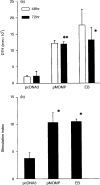Characterization of immune responses following intramuscular DNA immunization with the MOMP gene of Chlamydia trachomatis mouse pneumonitis strain
- PMID: 10233711
- PMCID: PMC2326737
- DOI: 10.1046/j.1365-2567.1999.00682.x
Characterization of immune responses following intramuscular DNA immunization with the MOMP gene of Chlamydia trachomatis mouse pneumonitis strain
Abstract
Studies were carried out to characterize the cellular and humoral immune responses evoked by intramuscular DNA vaccination with the major outer membrane protein (MOMP) gene of Chlamydia trachomatis mouse pneumonitis strain. The data demonstrate that DNA vaccinated mice develop antigen-specific delayed-type hypersensitivity, lymphocyte proliferation and interferon-gamma (IFN-gamma) production. Serum antibody responses (mainly immunoglobulin G2a; IgG2a) were evoked in two-thirds of the mice. We conclude that intramuscular DNA immunization with the MOMP gene evokes cellular and humoral immune responses suggestive of a T helper 1 (Th1) bias.
Figures





Similar articles
-
Priming with Chlamydia trachomatis major outer membrane protein (MOMP) DNA followed by MOMP ISCOM boosting enhances protection and is associated with increased immunoglobulin A and Th1 cellular immune responses.Infect Immun. 2000 Jun;68(6):3074-8. doi: 10.1128/IAI.68.6.3074-3078.2000. Infect Immun. 2000. PMID: 10816446 Free PMC article.
-
Immunization with the Chlamydia trachomatis mouse pneumonitis major outer membrane protein can elicit a protective immune response against a genital challenge.Infect Immun. 2001 Oct;69(10):6240-7. doi: 10.1128/IAI.69.10.6240-6247.2001. Infect Immun. 2001. PMID: 11553566 Free PMC article.
-
Codon usage bias in Chlamydia trachomatis and the effect of codon modification in the MOMP gene on immune responses to vaccination.Biochem Cell Biol. 2007 Apr;85(2):218-26. doi: 10.1139/o06-211. Biochem Cell Biol. 2007. PMID: 17534403
-
DNA vaccination with the major outer-membrane protein gene induces acquired immunity to Chlamydia trachomatis (mouse pneumonitis) infection.J Infect Dis. 1997 Oct;176(4):1035-40. doi: 10.1086/516545. J Infect Dis. 1997. PMID: 9333163
-
Transgene as vaccine for chlamydia.Am Heart J. 1999 Nov;138(5 Pt 2):S519-22. doi: 10.1016/s0002-8703(99)70291-7. Am Heart J. 1999. PMID: 10539864
Cited by
-
Intranasal vaccination with a secreted chlamydial protein enhances resolution of genital Chlamydia muridarum infection, protects against oviduct pathology, and is highly dependent upon endogenous gamma interferon production.Infect Immun. 2007 Feb;75(2):666-76. doi: 10.1128/IAI.01280-06. Epub 2006 Nov 21. Infect Immun. 2007. PMID: 17118987 Free PMC article.
-
Chlamydia trachomatis native major outer membrane protein induces partial protection in nonhuman primates: implication for a trachoma transmission-blocking vaccine.J Immunol. 2009 Jun 15;182(12):8063-70. doi: 10.4049/jimmunol.0804375. J Immunol. 2009. PMID: 19494332 Free PMC article.
-
Adjuvant modulation of the immune responses and the outcome of infection with Chlamydia pneumoniae.Clin Exp Immunol. 2002 Dec;130(3):393-403. doi: 10.1046/j.1365-2249.2002.02007.x. Clin Exp Immunol. 2002. PMID: 12452828 Free PMC article.
-
Priming with Chlamydia trachomatis major outer membrane protein (MOMP) DNA followed by MOMP ISCOM boosting enhances protection and is associated with increased immunoglobulin A and Th1 cellular immune responses.Infect Immun. 2000 Jun;68(6):3074-8. doi: 10.1128/IAI.68.6.3074-3078.2000. Infect Immun. 2000. PMID: 10816446 Free PMC article.
-
Immunization with Chlamydia psittaci plasmid-encoded protein CPSIT_p7 induces partial protective immunity against chlamydia lung infection in mice.Immunol Res. 2018 Aug;66(4):471-479. doi: 10.1007/s12026-018-9018-3. Immunol Res. 2018. PMID: 30097797
References
-
- Brunham RC. Vaccine design for the prevention of Chlamydia trachomatis infection. In: Orfila J, Byme G I, Chernesky M A, editors. Chlamydial Infections Proceedings of the Eighth International Symposium on Human Chlamydial Infections (Chantilly, France) Bologna, Italy: Società Editrice Esculapio; 1994. p. 73.
-
- Brunham RC, Peeling RW. Chlamydia trachomatis antigens: role in immunity and pathogenesis. Infectious Agents and Disease. 1994;3:218. - PubMed
-
- Stephens RS. Challenge of Chlamydia research. Infectious Agents and Disease. 1993;1:279. - PubMed
-
- Brunham RC, Kimani J, Bwayo J, et al. The epidemiology of Chlamydia trachomatis within a sexually transmitted diseases core group. J Infect Dis. 1996;173:950. - PubMed
-
- Jawetz E, Rose L, Hanna L, Thygeson P. Experimental inclusion conjunctivitis in man. JAMA. 1965;194:620. - PubMed
Publication types
MeSH terms
Substances
LinkOut - more resources
Full Text Sources
Other Literature Sources
Medical

